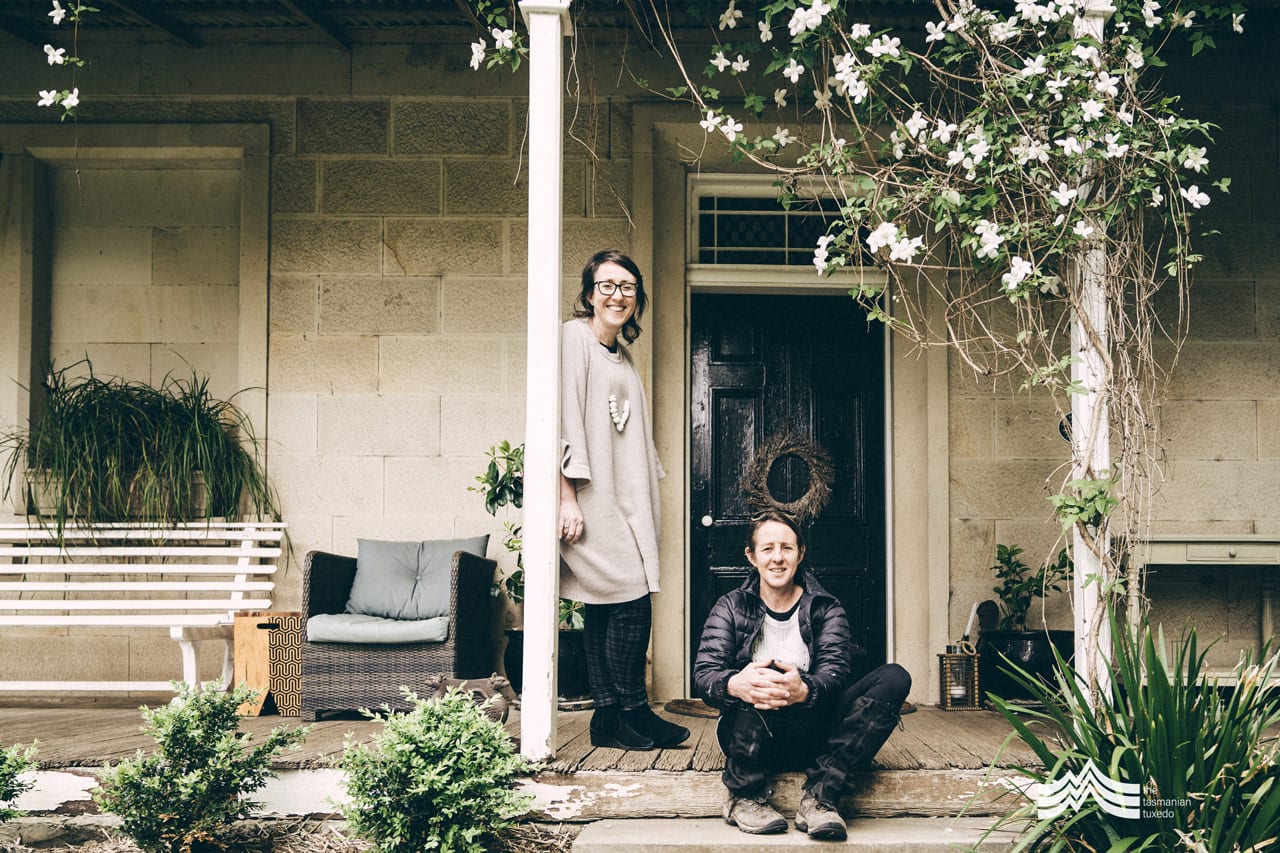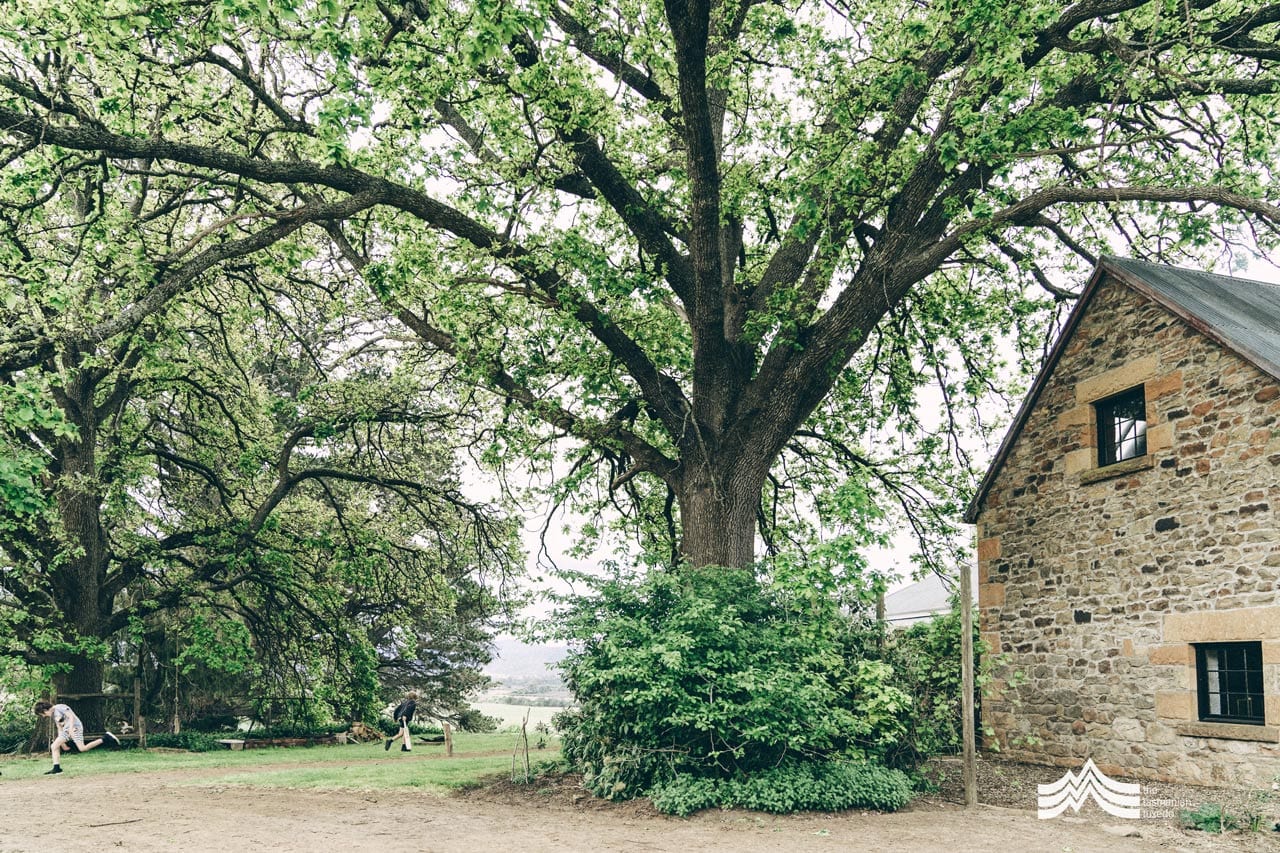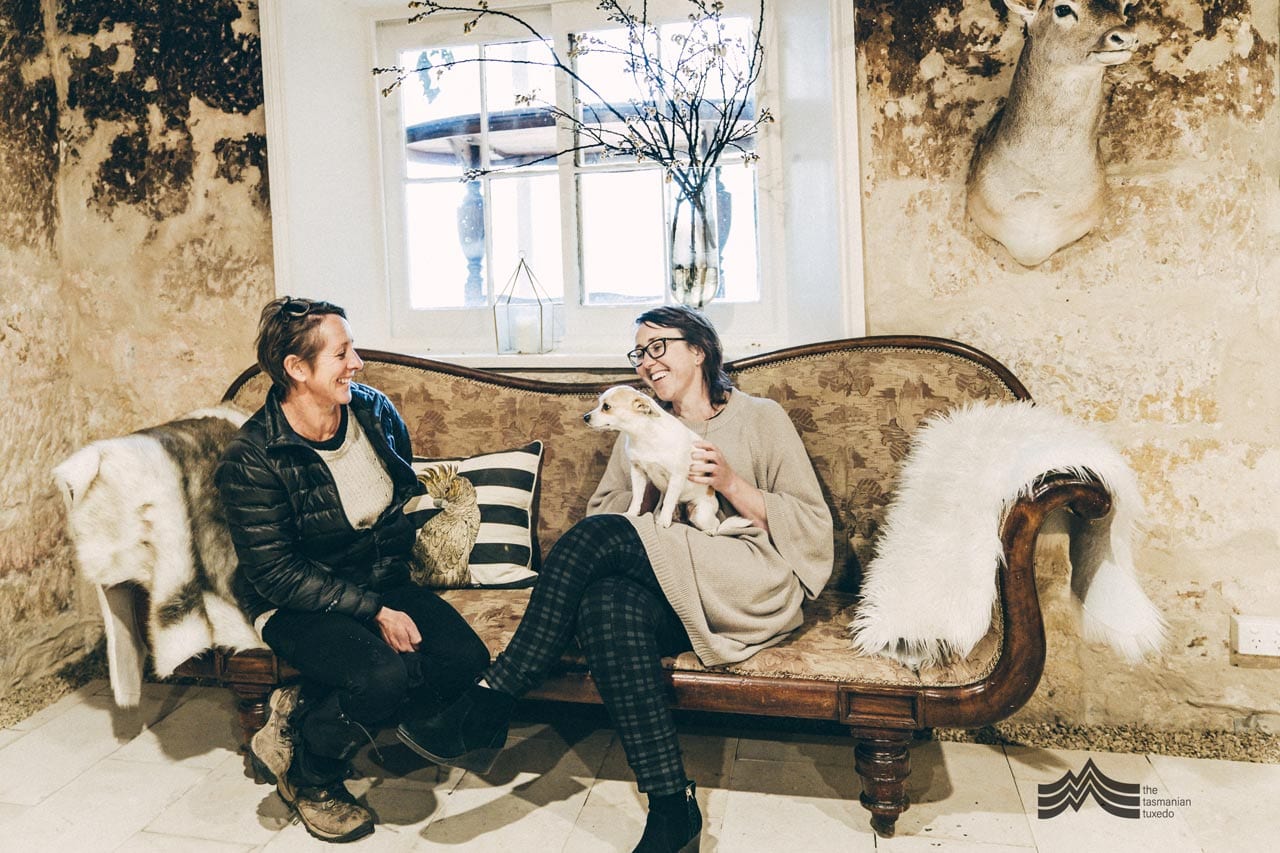The rural hamlet of Buckland in Tasmania’s south east is easily overlooked. Once an important overnight stop for coaches and horses transporting convicts to east coast probation stations, it’s now a tranquil home for a population of less than 200. Originally settled in the 1820’s on the plains of the Prosser River, it holds the secrets of many villains, bushrangers and crafty trappers who lurked in the town’s shadows. However what’s even more intriguing is what awaits on Buckland’s outskirts.
The journey to Twamley Farm is an adventure in itself. A 5km meander off the highway takes you through the valley’s fertile flood plains. Bit by bit, this road less travelled quickly reveals a land perfect for farming – indeed illustrating just how Buckland rode on the sheep’s back for a large portion of the 20th century.
Twamley homestead was built by Francis Smith in 1842. White sandstone was sourced specifically from Bellerive and handcrafted to pay fitting homage to the largest land grant in the district. A stately and elegant Georgian residence, typical of the period in its three level design, this family home was later graced by a 1920’s addition of a generous verandah to aid in shielding itself from the elements. Originally sitting proudly on over two and a half thousand acres, Twamley has since expanded as further parcels of convict land were tacked on over time.

Sweeping up the lower flanks of Charlie’s Hill, arrival at the picturesque homestead is a feast for the eyes. Two imposing oak trees dwarf the house and stables, standing guard over a traditional English farm garden. It’s rustic charm meeting grazier chic. Your cares and worries melt away as you loose yourself in a delightfully shaded oasis, a fitting contrast against the blazing sun belting down on the working paddocks below. The warm hospitality that emanates from sisters Angela and Elizabeth Turvey is the icing on the cake.
Elizabeth explains, “Our friends always comment how amazing it is here…they sit for hours here on the verandah taking in the views.” She pauses and considers her thoughts for a moment, “Sometimes you don’t realise what your own home is actually like for visitors. It’s been really great to be able to open Twamley to guests in recent years.”

The Turvey family took Twamley’s reins in the 1870’s. John West Turvey was the first to settle in the area, having arrived in Van Diemen’s Land in 1823 after being transported from England, rather ironically, for sheep stealing. Once granted his ticket of leave in 1833, he gave rise to the Turvey tradition of sheep farming and wool growing that has continued to the present day. His son, Frank Turvey, was the first in the family to live on the property and whilst he ran it as a successful grazing business it was likely he also dabbled in trapping to satisfy local market demand for quality possum skins.
With well over a century of success producing super fine merino wool, the business was forced to diversify after wool prices took a dive in the 1990’s. Reinventing itself as a dual purpose venture, Twamley has since continued to produce quality meat and wool for both the local and export markets.
“I worked on the farm for twenty years,” says Elizabeth, who clearly knows every inch of the property like the back of her hand. “My brother Alistair is now running the agri-business side of things while Angela and I are building up the tourism market.” With an infectious laugh she adds, “That’s not to say I still don’t love interfering with the farm itself.”

Angela is active throughout the district and heavily involved with East Coast Tourism. “There are so many great things happening in the area,” she enthuses. “We have an amazing array of boutique ventures, and many of them work closely together to provide genuine and unique experiences for visitors.” Twamely is no exception. “The response of our guests is pretty special. Besides our accommodation, we’re becoming known for our long table lunches, garden parties and small private functions. It’s a beautiful venue and it’s wonderful to work with local suppliers to showcase Tassie produce.”
Long afternoons at tables laden with seasonal Tasmanian food and wine are becoming a signature. Personal ties with a local family caterer, Gert and Ted, means the fare is tailored to match Twamley’s style – unique, abundant and rustic. Spreads on the rich green lawns are interspersed with more intimate dinners in the homestead’s cellar, now set up to welcome guests on chilly evenings where they can dine in front of a roaring fire.
To allow visitors to make the most of their time at Twamley, Angela and Elizabeth have converted their stunning two story 1840’s stables to a romantic country getaway. Guests can unwind in style – think open fires, luxury robes, and fine Tasmanian wine and local gourmet produce – all whilst taking in the rough local sandstone and blue gum timber beams. “Summer visitors usually spend their evenings on the outdoor terrace in front of the fire pot. We’re also just about to tuck a hot tub into the garden which will take things to another level,” says Angela.

A newer addition includes the Farm Pod – a contemporary hideaway with an eclectic country vibe. It also offers a private garden with everything you could wish for in a country retreat – verandah, fire pot and sweeping views included. An added bonus is the ability to book the adjacent 5 metre bell tent and snuggle down under the feather doona and merino blankets. It’s African safari meets luxurious country style.
The serenity of these surroundings inspired many of the works of famous writer and illustrator Louisa Anne Meredith. Calling Twamley her home from 1858 – 1867, she also lays claim to the property’s current name. Welsh in origin, as was Louisa herself, Twamley was Louisa’s maiden name. Upon arrival in Tasmania she quickly discovered that being the wife of a local politician was not without its challenges. Charles Meredith had a reputation for alcoholism and was often embroiled in financial turmoil. Often absent from home for work, Louisa was left to face the isolation at Twamley alone, contending with the constant threat of bushrangers lurking in the thick scrub that surrounded the homestead at the time.
Not to be deterred, the period saw her continue her passion for sketching bush flora and fauna. The Twamley period also saw her immerse herself in fiction, perhaps as an escape from reality. By the time of her death in 1895, Louisa’s wildflower drawings had won medals across the world, most notably in the Melbourne Exhibition of 1866. She had a keen interest in the natural environment, studied insects, fish and seaweed and became an active member of the Society for the Prevention of Cruelty to Animals. In 1884 the Tasmanian government granted Louisa a pension of £100 for her ‘distinguished literary and artistic services’ to the colony.
Twamley’s shearing shed was relocated to its current position in 1897. The huon pine boards at its entrance hail from the original shearing board and its structure is made from hand split timbers. Whilst a working shearing shed by day, it occasionally transforms itself by night into a magical setting for small functions. “Drinks and canapés are great in here” explains Elizabeth. “Our visitors love soaking in the history of the place and they can spill out onto the grass and chat around an open fire under the stars.”

Most of Twamley’s guests enjoy the simple pleasure of getting away and taking the time to unwind. Besides wandering the gardens and taking in the inner workings of grazing life firsthand, visitors are encouraged to explore the numerous walking and mountain bike trails. A range of options will take you along old paths carved into hillsides, through to more challenging routes that take in vantage points of stunning country vistas. A day trek along a rough vehicle track eventually gives way to cool temperate rainforest and finally demands a climb over a rocky outcrop. The summit of Prosser Sugarloaf rewards explorers with views from the Tasman peninsula right across to the city of Hobart.
“Twamley was a magical place to grow up,” Elizabeth fondly recalls, watching her own son resting in the limbs of the towering radiata pine in the front garden. “My grandparents lived in the main house then and we were in the place just down the road. We’d come up here all the time…there were adventures to be had everywhere.” A particularly favourite were nights spent with girlfriends camped out in the old Shearers Hut. “You can just imagine a bunch of teenage girls in there for a night,” Elizabeth grins. “There were a lot of laughs, midnight snacks and ghost stories.”
Built by the Turvey’s in the early 1900’s to provide shearers with accommodation, the simple baltic pine hut remains in excellent condition. Sitting on a hillside adjacent to the main homestead, it houses a treasure trove of items from across Twamley’s past. Today guests can enjoy an evening in front of the original fireplace, browse through perfectly preserved mid-century newspapers and magazines, and even trace the shearer’s success through the tally boards that remain on the huts walls.
Tales of Tasmanian tiger trappings are also bound to Twamley. Local legend Elias Churchill, perhaps the best known of the state’s tiger hunters, is also said to have had a hut on the property around the late 1920’s. At the time the elusive thylacine was in demand by zoos across the world. Churchill is credited with trapping 8 thylacines for Beaumaris Zoo in Hobart, including the last one to die in captivity in 1936. “The rubble of the hut is still there, you can walk up there and see the remains of the chimney,” says Elizabeth.
“This area is full of gorgeous properties with amazing histories,” says Angela. “Each one of them is unique, but it’s lovely that here in Tasmania there are so many interconnected stories.” She stops to gaze around the garden and consider the Turvey story. “We’ve really been enjoying welcoming guests to Twamley and sharing our family home. This place is pretty hard to beat.”

Twamley Farm is situated a leisurely one hour drive from Hobart. It is open to guests year round, enquiries via www.twamleyfarm.com.au
